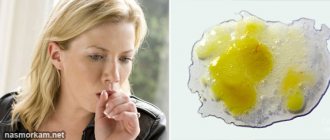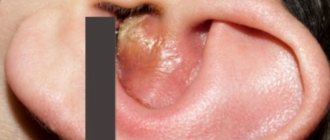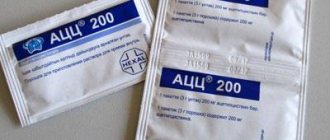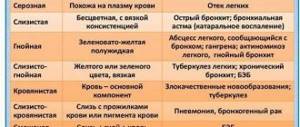Functions of sputum
The bronchi and other respiratory tracts are lined from the inside by the mucous membrane. It performs a very important function - protective .
All foreign particles (dust, viruses, pollution) stick to the mucous membrane and are then removed from the body with a cough.
In infectious diseases, when too many viruses enter, the mucous membrane begins to work more actively , which leads to increased production of its secretions.
For bronchitis and other respiratory diseases, the help of sputum in the fight against the pathogen is invaluable.
The set of characteristics of bronchial secretions is called rheology. This includes density, viscosity, fluidity and more. One of the most important indicators is the color of sputum. Often it becomes the diagnostic criterion for determining treatment tactics.
Why does sputum appear and how is it removed?
In acute or chronic bronchitis, during the period of exacerbation, the mucous membrane thickens and begins to secrete secretions more actively. Due to the fact that it remains in the lumen of the bronchi and makes breathing difficult, a compensatory mechanism is activated - cough . Coughing removes excess mucus from the body and clears the airways.
For normal functioning of the mucous membrane, it must be moisturized . Natural hydration occurs both from within the body (thanks to drinking plenty of fluids) and from the outside (by inhaling moistened air). If the mucous membrane is not sufficiently moistened, the secretion is produced and separated poorly. Patients describe this condition as “sputum does not come out or is poorly expectorated.”
Is there any way to improve sputum discharge? Medications or regular moisturizing may help. Detailed treatment will be described below.
Main components of sputum
Sputum during bronchitis is a pathological phenomenon, since it is physiologically determined that no discharge should be observed from the respiratory tract.
Sputum during bronchitis is formed in response to inflammation, and along with it, dead cells located on the mucous membrane, as well as microbes, are removed from the respiratory tract.
In acute or chronic bronchitis, sputum is mucus formed in the respiratory tract and containing:
- cells of the immune system;
- microorganisms;
- cell decay particles;
- tiny specks of dust;
- blood components represented by plasma and blood cells (typical for sputum with blood).
Sputum color
By the color of the sputum, the doctor can determine what process is occurring in the body.
White color. Normally, bronchial secretions should be white and transparent.
Frequent cough with sputum of this color may indicate chronic bronchitis. The same color is observed at the beginning of an acute inflammatory process. Yellow sputum. This shade is given by immune cells - neutrophils. Their entry into the source of inflammation indicates the presence of an infectious or allergic component. Smokers also have a similar color of sputum, which is explained by the presence of nicotine and chronic pathology.
Green color. When immune cells decay, they give the mucus a greenish tint. More often this indicates an infection that has been going on for a long time. Yellow-green shades may indicate a bacterial pathogen.
Brown sputum. The color is caused by the breakdown of red blood cells. This usually happens with severe bronchitis or toxic damage to the respiratory tract.
red tints to the secretion. It is important to pay attention to the frequency and duration of such discharge. If this condition continues for several days, complications or diseases such as tuberculosis and thromboembolism can be assumed. Streaks of blood usually do not appear in acute bronchitis, so this symptom requires consultation with a doctor.
Normally, sputum is odorless. Its appearance indicates a pathological process, more often - rotting microorganisms. As a rule, an unpleasant odor is accompanied by mucopurulent discharge.
What does the color of sputum mean in bronchitis?
Sputum during bronchitis can be of different colors and types depending on the nature of the disease.
Gray or white sputum
It is natural to produce gray or white mucus when coughing, but excessive amounts of mucus may indicate chronic bronchitis.
Yellow
The release of a yellow secretion is characteristic of the presence of neutrophils in the mucus, which belong to a subtype of leukocytes, which may indicate an infectious, chronic or allergic form of bronchitis. In addition, a similar color of secretion is present in smokers. The yellow color of the secretion released during a cough is not normal and requires consultation with a doctor to determine the root cause of the development of bronchitis.
Green
The discharge of green (purulent) sputum may indicate old infectious bronchitis. With the non-infectious nature of the disease, clear white mucus is present in the green sputum.
Brown
Brown mucus that appears during a cough indicates the destruction of red blood cells and the release of hemosiderin (a breakdown product of hemoglobin). Brown sputum, which contains hemosiderin, appears in patients with left ventricular failure and pulmonary infarction as a result of red blood cells sweating from the bloodstream into the alveoli and bronchi.
Sputum with blood
Red blood cells that enter through the vascular walls can turn the bronchial secretions pink. With a large amount of these elements, the secretion acquires a red tint, which indicates rupture of the blood vessels.
Important! The presence of sputum during a cough can indicate not only bronchitis, but also a number of other diseases, so testing is a priority.
Features of sputum in various diseases
- Acute bronchitis . In the initial stages, bronchial discharge is white and has a jelly-like consistency. As the immune system fights germs, the sputum changes color to yellow-green. Improvement in the patient’s well-being, weakening of symptoms and the transition of the color of the secretion from transparent to yellow indicates the beginning of recovery.
- Chronical bronchitis . A lot of sputum is produced. As a rule, it is transparent, odorless, and has a thicker consistency. During periods of exacerbation, the color may change to yellow-green.
- Pneumonia . The mucus turns yellow due to the addition of bacterial flora. If the lung tissue begins to be affected, streaks of blood appear in the secretions.
- Non-infectious inflammatory process . Viscous sputum, in which a large number of eosinophil cells are found, indicates, for example, allergic bronchitis.
How to distinguish pneumonia from bronchitis? One of the diagnostic criteria is the nature of the sputum and the results of its analysis.
Types of sputum for bronchitis
The type of sputum during bronchitis directly depends on its degree. At the initial stage of the disease, there is a non-productive (dry) cough, which then turns into a wet one. In the middle of the disease, the discharge of mucous secretion can be painful, but as the inflammatory process subsides and the body temperature decreases, the pain syndrome disappears.
With bronchitis, sputum may be:
- mucous (viscous whitish or clear liquid);
- serous-mucous (viscous white mass, capable of foaming under the influence of air impurities);
- purulent (viscous liquid of green, dark yellow and yellow color).
Character of sputum by color
The release of mucous secretion is observed in mild stages of bronchitis and moderate (up to 38.5 o C) hyperthermia. Mucous-serous sputum is present at the middle stage of development of bronchitis and an increase in body temperature to 39 degrees. The sputum accompanying chronic bronchitis may be colorless or mixed with dust, for example, in patients whose professional activities are associated with mines, cement factories, etc.
A decrease in the body's defenses with secondary infection can lead to the appearance of a purulent secretion with an unpleasant odor. This condition is one of the most severe and requires hospitalization of the patient.
The appearance of mucous secretion caused by the allergic form of bronchitis is explained by exposure to allergens (dust, chemical components, tobacco smoke, etc.) on the respiratory tract.
With smoker's bronchitis, the secretion is viscous and yellowish. Its appearance is caused by irritation of the respiratory tract from tobacco smoke and tar. With the development of obstructive bronchitis, spastic narrowing of the bronchial walls is noted, accompanied by shortness of breath and difficulty in simultaneous exhalation. In this case, the secretion has the same consistency and color as in allergic bronchitis.
Sputum analysis
The first doctor who can help a patient is a therapist. Next, you may need to be examined by an allergist or pulmonologist. Analysis of cough discharge can be prescribed by any of the specialists.
The results of the study can tell a lot about the disease. The analysis not only determines the pathogen that provoked the inflammation, but also examines exfoliated epithelial cells.
Based on the presence of such additional inclusions, a more accurate conclusion can be made about the localization of the lesion and the stage of the pathological process.
Before collecting material, it is recommended to brush your teeth and rinse your mouth. It is better to collect sputum in the morning, before meals. Place it in a sterile container and submit it to the laboratory . Only 3 ml of discharge is enough for the study.
Treatment
The removal of sputum is an important step in the healing process. The more effectively the airways are cleared, the faster they are restored. To liquefy viscous sputum and ensure good release of it, the following are recommended:
- Expectorants . Syrups based on ambroxol are effective for children. For difficulty breathing and narrowing of the lumen of the bronchi, complex medications can be used. In addition to the expectorant component, they contain a substance that dilates the bronchi and relieves spasms. For adults, expectorants are more convenient to use in tablet form.
- Inhalations . A good way to safely and quickly moisturize the respiratory mucous membranes. Inhalations can be done with hot steam based on herbal decoctions (chamomile, sage, thyme, calendula) or using an inhaler (with the addition of mineral waters).
- Mucolytics . These medications break up mucus into smaller pieces, making it easier to remove. Effectively treat bronchitis with a combination of mucolytics and expectorants.
- Folk remedies . Good results are obtained from the use of breast milk for bronchitis in adults. A specially selected combination of plants helps clear the airways and relieves inflammation. Aloe and bee products have a good antibacterial effect. Bronchitis in a baby under one year of age is preferably treated with folk remedies or medicines based on herbal ingredients.
- Exercises and massage . Physical pressure can help separate mucus from the walls of the mucous membranes. It is useful for small children to do drainage massage, and for adults - special therapeutic exercises or warming procedures. If you have any doubts about whether it is possible to take a steam bath if you have bronchitis, it is better to get a doctor’s permission. This folk method works well to clear the airways. An alternative could be the Samozdrav breathing simulator, which eliminates bronchospasm, facilitates breathing and promotes the removal of mucus.
- Antihistamines . They are used to treat allergic bronchitis in children, as well as in infectious processes to relieve swelling and inflammation.
How long to treat depends on the patient’s immunity and the quality of compliance with all recommendations. By creating the right conditions for good mucus discharge, you can get rid of bronchitis without medications.
Drinking plenty of fluids will help avoid drying out of the mucous membranes and enable the body to cope with the disease on its own.
What to drink with viscous sputum does not matter, but the liquid should be warm . The discharge then becomes more liquid, and the pieces become smaller.










